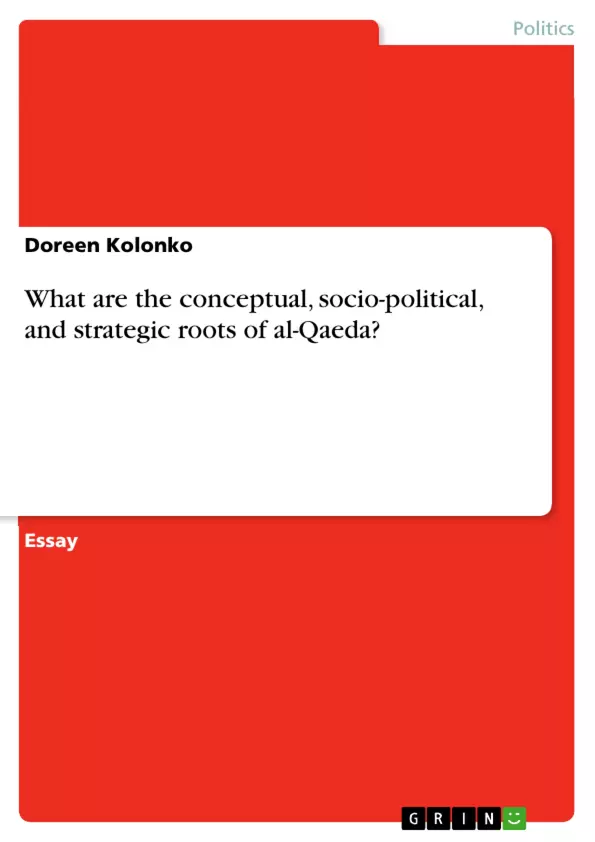Until today, scholars worldwide aim to reveal the “real” nature of the terrorist organization al-Qaeda. However, only in the rarest case an integrated approach is applied to analyze the root causes of its emergence, conceptual and strategic ideas. This essay argues that these considerations are essential to acquire a broader understanding. Therefore, I aim to contextualize al-Qaeda’s emergence within the Middle Eastern socio-political landscape and explore the genesis of its conception and strategy applied today. In doing so, I furthermore illustrate the foundation of its call for the establishment of a new caliphate inhabiting the Arabian Peninsula within the tradition of fundamentalist Sunni Islam.
Inhaltsverzeichnis (Table of Contents)
- Introduction
- Socio-political roots: the impact of resentment
- Conceptual roots: returning to the "true Islam"
- Strategic roots: reviving the past
- Conclusion
- Bibliography
Zielsetzung und Themenschwerpunkte (Objectives and Key Themes)
This essay aims to provide a comprehensive understanding of the terrorist organization al-Qaeda by exploring its conceptual, socio-political, and strategic roots. It contextualizes the group's emergence within the Middle Eastern socio-political landscape, examines its core beliefs and strategies, and highlights the foundation of its call for a new caliphate in the Arabian Peninsula.
- The socio-political roots of al-Qaeda in the context of resentment and instability in the Middle East.
- The conceptual roots of al-Qaeda in the idea of returning to "true Islam" and its rejection of modern influences.
- The strategic roots of al-Qaeda in its call for jihad against both internal and external enemies.
- The role of Saudi Arabia in al-Qaeda's strategic calculations.
Zusammenfassung der Kapitel (Chapter Summaries)
- Introduction: This chapter provides an overview of the essay's objectives and outlines the importance of understanding al-Qaeda's roots in order to fully comprehend its actions.
- Socio-political roots: the impact of resentment: This chapter explores the socio-political context of al-Qaeda's emergence, highlighting the impact of population growth, urbanization, and economic instability on the Middle East. It argues that these factors contributed to resentment towards existing governments and created fertile ground for radicalization.
- Conceptual roots: returning to the "true Islam": This chapter delves into the ideological foundations of al-Qaeda, tracing its roots back to the Wahhabi interpretation of Islam. It examines the idea of a "moral decline" in Muslim society and the need to return to the original principles of the faith.
- Strategic roots: reviving the past: This chapter analyzes al-Qaeda's strategic thinking, focusing on its use of jihad as a tool for liberation and its targeting of both "near" and "far" enemies. It also explores the group's strategic interest in Saudi Arabia and its perceived "betrayal" of Islamic principles.
Schlüsselwörter (Keywords)
The key themes and concepts explored in this essay include: al-Qaeda, terrorism, Middle East, socio-political roots, conceptual roots, strategic roots, Wahhabism, Salafism, jihad, Saudi Arabia, Islamic Golden Age, ummah, caliphate, Western imperialism, resentment, instability, globalization, and religious reform.
- Quote paper
- Doreen Kolonko (Author), 2018, What are the conceptual, socio-political, and strategic roots of al-Qaeda?, Munich, GRIN Verlag, https://www.grin.com/document/499440



